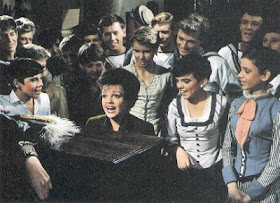 |
| Verne's inner ocean from the 1959 movie. |
|
|
|
|
|
JOURNEY INTO THE INTERIOR OF THE EARTH. Jules Verne.
Jules Verne's influential 1877 novel about a fantastic journey into the interior of the planet has been filmed, ripped off and bowdlerized a great many times. In Verne's book the German professor Liedenbrock and his nephew Axel, along with an Icelander named Hans, descend into a crater and laboriously make their way into the interior of the planet. Liedenbrock finds a parchment from 16h century alchemist Arne Saknussemm in an old book in which Saknussemm tells of reaching the center of the earth via the extinct crater Snaefell "in the shadow of Scartaris" -- but they must arrive on a certain day so that the correct pathway will be pointed out by the sun's rays. Axel is much less enthused about the undertaking than his somewhat nutty uncle [the whole idea of beginning such an adventure because of old writings that might have been fictional in the first place is a little ridiculous] and the two come into conflict more than once during the journey. Axel's girlfriend Grauben actually encourages him to go on the trip. The two men have a variety of flavorful adventures before they even enter the crater, all bolstered by Verne's well-researched [and often
too exhaustive] descriptions.
Once inside the earth, the trio have an often harrowing time of it, nearly turning back due to lack of water, and Axel gets completely lost in the darkness at one point. They eventually come across a gargantuan cavern containing an ocean and which is in a perpetual state of twilight due to a kind of aurora borealis of electrical origin. On the shore they find mushrooms grown to huge size due to the constant warm temperature, as well as other kinds of flora. Setting sail on the inner ocean on a raft they witness a terrifying battle between two prehistoric saurians, a plesiosaurus and an ichthyosaurus, that nearly swamps their raft. Just as terrifying is the appearance of a fireball that hovers and darts about and around the raft and a crackling, stupendous storm that brings them back to the shore they left, although on this point they aren't certain. Here they discover living mammoths, as well as a 12-foot tall shepherd whom they wisely run from before he can spot them.[Liedenbrock theorizes that in ancient times living people and animals were carried down via earthquakes, and survivors now populate the inner earth.]
They then discover a passage taken by Saknussemm that would lead them further downward, but it is blocked. Using explosives to clear the stone barrier, they create a cataclysm that shoots them and their raft into an adjacent chamber of a live crater and are shot up to the earth [in spurts] in a live volcano.
Journey into the Interior of the Earth is a wonderful fantasy novel bolstered by Verne's research, descriptions and lively imagination, even if it does become a little outlandish. One could argue that the book ends just when it gets really interesting. Liedenbrock and Axel are one-dimensional characters, but it is the adventure, the whole fascinating premise, that carries the story. [Later on Edgar Rice Burroughs, creator of Tarzan, would run with the idea and create Pellucidar, an inner world inside a hollow earth populated by monsters and cavemen and different, weird societies.]
Most of the film adaptations are too dreadful to mention. The 1959
Journey to the Center of the Earth, despite much foolishness, is so far the best of them. Liedenbrock was turned into a Scottish professor Lindenbrook, and Axel became, Alec, one of his students, but no relation. Lindenbrook was given a daughter who is romanced by Alec. Instead of a parchment, Saknusemm's message is found on a plumb bob. The screenwriters invented all the business involving Arne Saknusemm's descendant, the rival Professor Goteborg and his wife (who goes along on the trip), the duck Gertrude, and the discovery of some ruins of Atlantis in the bowels of the earth. The characters in the film reach the very center of the earth, but in the novel they do not. The 1977 Spanish film
Where Time Began was in some ways more faithful to the novel but also took many a liberty in the story and was not memorable.
Verdict: Fascinating, if flawed, fantasy novel by one of the giants. ***.



























